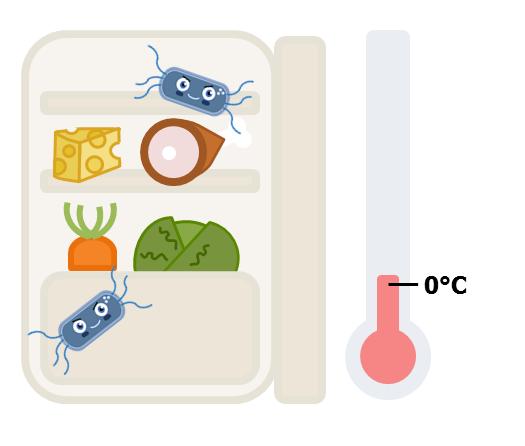Listeria monocytogenes
Listeria monocytogenes is a gram-positive, foodborne pathogen responsible for listeriosis. It is a particular threat as it can survive a range of pH’s as well as temperatures as low as 0°C allowing it to survive in industrial and domestic refrigerators. This pathogen commonly contaminates unpasteurised dairy products, particularly soft cheeses, as well as fresh vegetables and cooked meats.

The presence of as little as 100 L. monocytogenes cells per gram of food can lead to symptoms ranging from fever, diarrhoea, and muscle aches to more severe ailments such as meningitis and sepsis (Vázquez-Boland, J.A. et al., 2001). Whilst in the majority of healthy people listeriosis manifests itself with flu-like symptoms, it can be fatal for immunosuppressed individuals like people suffering from AIDS or pregnant women who can suffer from fetal infections and miscarriage.
The annual incidence of listeria is said to be between 1,795-1,860 per 100,000 with up to a 30% mortality rate" -- that would be 40 million deaths due to listeria every single year (USDA ERS, 1996)! That's 100 times the death toll of malaria, and five times the number of people dying of cancer.
The Problem & Our Original Solution
Currently, there are tests to detect the presence of Listeria. These include the Anton Test (Hitchens, D. et al., 2017) or the Rapid Neogen Test which both have their own drawbacks. The Anton Test is time-consuming, taking 24 hours and involves inoculating the conjunctiva of a guinea pig or rabbit to invoke an immune response. In contrast, the Rapid Neogen Test only takes 60 minutes, however, the machinery required is expensive costing around $11,000, which is often too much for small-scale businesses.

Our project aims to improve Listeria testing, particularly in soft cheeses, by developing a biosensor that is fully integrated into the soft cheese starter culture. The biosensor would be based on Listeria's quorum sensing mechanism and would detect the signalling molecule released by the pathogen. The signalling molecule, an autoinducing peptide (AIP), will trigger a significant colour change (to purple) in the cheese product, allowing for fast detection of Listeria either during the cheese making process or at any point of the product's shelf life. We hope to accomplish this by transferring the AIP responsive genes from Listeria monocytogenes into Lactococcus lactis, the most common lactic acid bacteria species utilised as a starter culture for cheese manufacturing.
Agr Quorum Sensing in Listeria monocytogenes
The agr gene regulatory system is involved in the biofilm formation and virulence in L. monocytogenes (Zetzmann, M. et al., 2016). This agr quorum sensing system is highly specific to L. monocytogenes and relies on the production of AIP through genes agrA/B/C/D. AgrC is a membrane protein which detects extracellular AIP and induces intracellular cascade leading to the phosphorylation of a transcription factor AgrA followed by an upregulated transcription of agrD/B which produce and secrete more AIP (Figure 1).

What is AIP?
AIP is highly specific to L. monocytogenes although other AIP molecules are produced by homologous species. AIP is a cyclic pentapeptide with the amino acid sequence CFMFV forming a thiolactone ring and acts as a signalling molecule in a quorum sensing mechanism in Listeria.

Detection & Response
Modified L. lactis will contain agrC and agrA to detect AIP and cause a response. Activation of AgrA through histidine kinase phosphorylation will then cause AgrA binding to the PII promoter and induce transcription of chromoprotein amilCP as a reporter (Fig. 2).

Figure 2. Lactococcus lactis detection and response system
Since we are not allowed to work with Listeria in the lab, we still need to be able to check if the response by L. lactis bacteria is produced. For this purpose, we designed Escherichia coli which is able to synthesise the Listeria specific AIP molecule (Fig. 3).

Figure 3. AIP production in Escherichia coli
References
Radoshevich, L and Cossart, P. 2018. Listeria monocytogenes: towards a complete picture of its physiology and pathogenesis. Nature Reviews Microbiology. 16. 32 - 46
Zetzmann, M. et al. 2016. Identification of the agr peptide of Listeria monocytogenes. Frontiers in Microbiology. 7. 989.
-
Garmyn, D. et al. 2009. Communication and auto induction in the species Listeria monocytogenes A central role for the agr system. Communicative and Integrative Biology. 2. (4) 371 - 374.
USDA Economic Research Service, “Bacterial Foodborne Disease—Medical Costs and Productivity Losses,” AER-741, August 1996 (authors: Jean C. Buzby, et al.)
Hitchens, D. et al. 2017. Detection of Listeria monocytogenes in Foods and Environmental Samples, and Enumeration of Listeria monocytogenes in Foods

